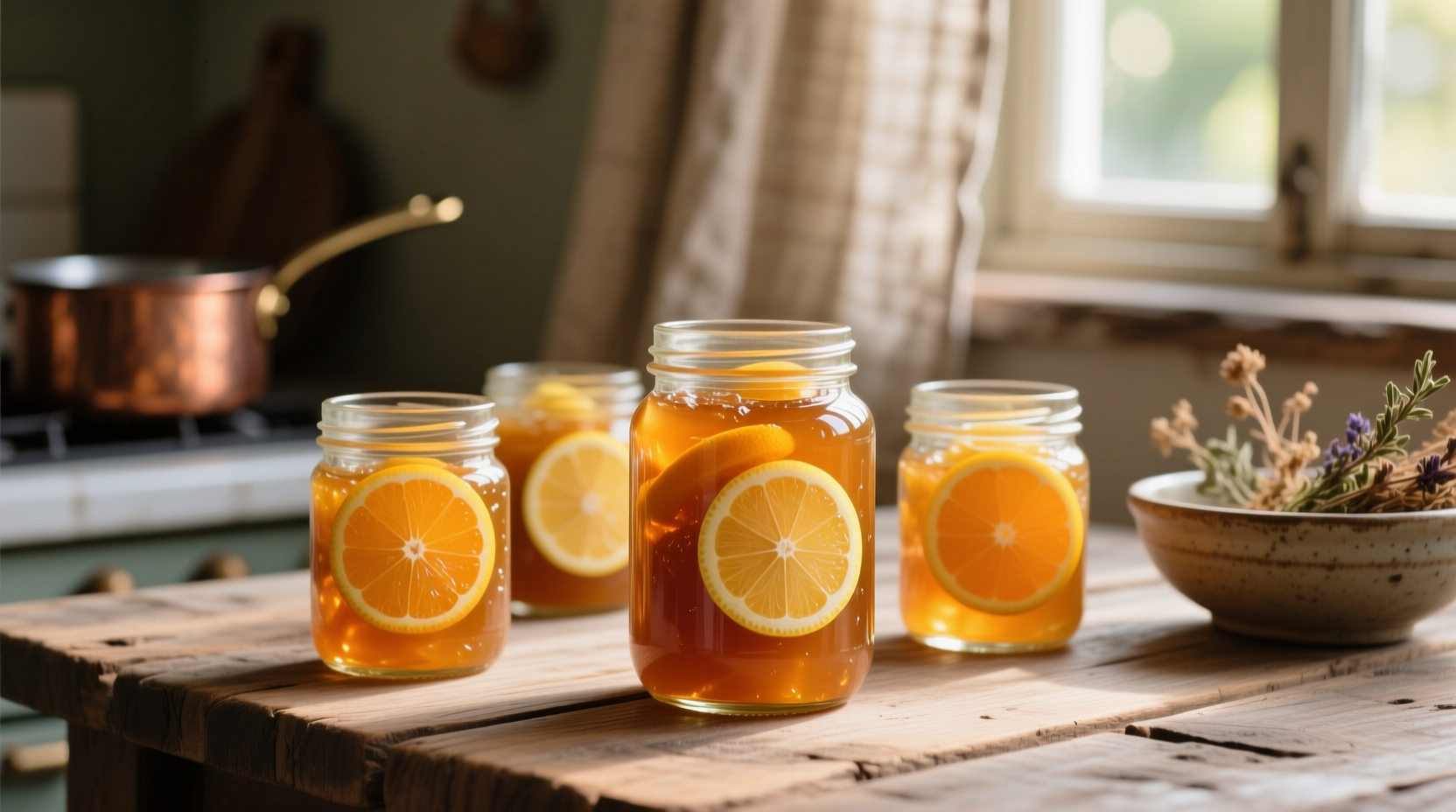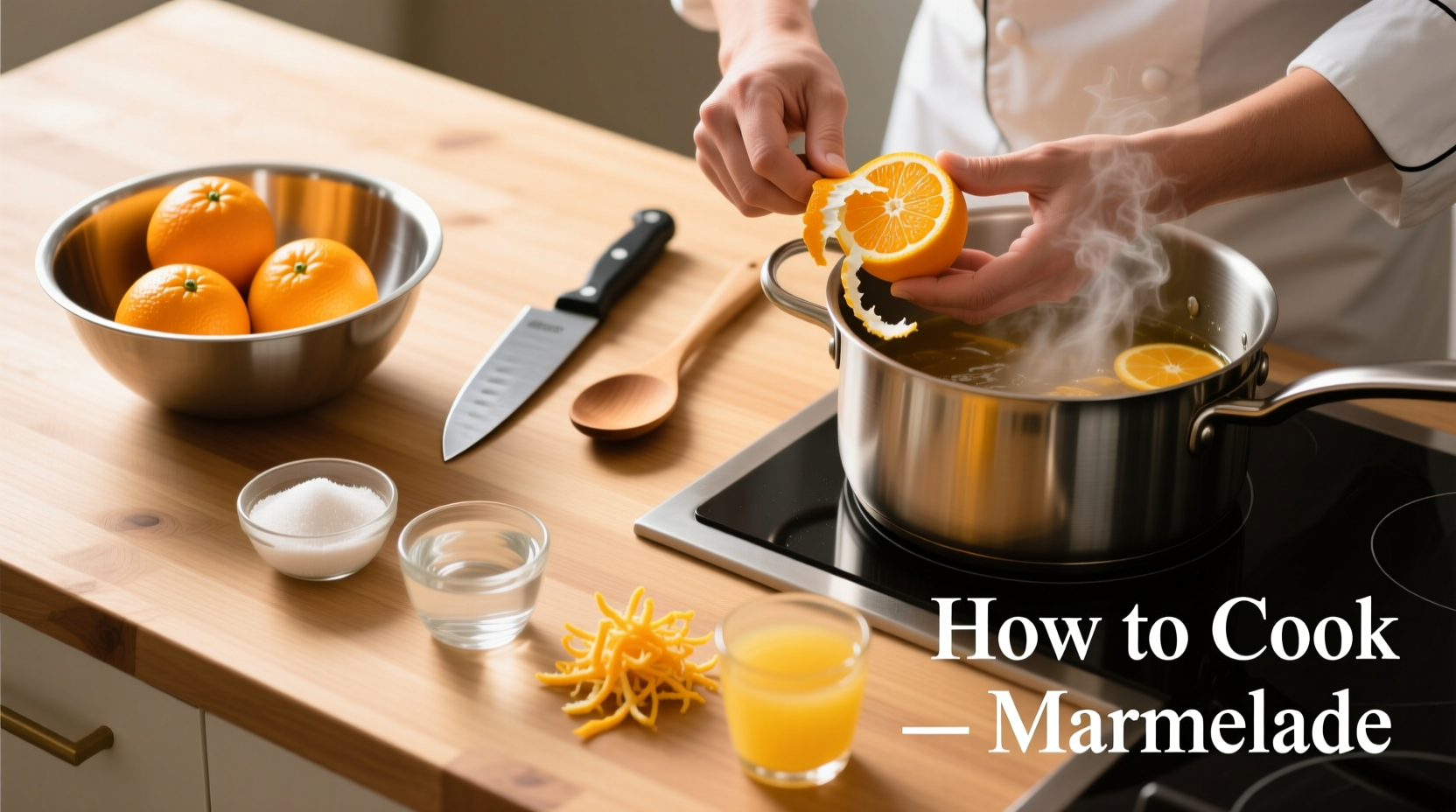The perfect marmalade requires equal weights of prepared citrus and granulated sugar, simmered to 104-105°C (220°F) or until it passes the wrinkle test on a chilled plate. This traditional citrus preserve takes approximately 2 hours from preparation to jar sealing, with critical attention needed during the boiling stage to achieve the ideal jelly-like consistency with suspended peel.
Mastering Homemade Marmalade: Your Complete Guide to Citrus Perfection
There's nothing quite like the vibrant flavor of homemade marmalade spread on warm toast. Unlike store-bought versions, crafting your own allows complete control over sweetness, peel thickness, and citrus variety. Whether you're preserving winter oranges or experimenting with seasonal citrus, this guide provides everything you need for consistent, professional-quality results every time.
Why Homemade Marmalade Beats Store-Bought
Commercial marmalades often contain artificial preservatives and high-fructose corn syrup, compromising both flavor and texture. When you make marmalade from scratch, you control the sugar content, select premium citrus at peak ripeness, and create a preserve with superior mouthfeel and complex flavor notes. The process itself connects you to centuries of culinary tradition while yielding a product that captures the essence of fresh citrus.

Essential Equipment Checklist
Before starting your marmalade journey, gather these critical tools:
- Heavy-bottomed preserving pan (stainless steel or enameled)
- Accurate kitchen scale (volume measurements won't yield consistent results)
- Candy thermometer (digital preferred for precision)
- Chilled saucers for wrinkle testing
- Sterilized glass jars with new lids
- Wooden spoons and silicone spatulas
- Fine-mesh strainer
Citrus Selection: The Foundation of Great Marmalade
The quality of your marmalade begins with your citrus selection. While Seville oranges remain the traditional choice for their high pectin and bitter notes, modern marmalade makers have expanded their repertoire:
| Citrus Variety | Pectin Level | Flavor Profile | Best For |
|---|---|---|---|
| Seville Oranges | Very High | Intensely bitter, complex | Traditional English marmalade |
| Navel Oranges | Moderate | Sweet with mild bitterness | Beginner-friendly marmalade |
| Grapefruit | High | Bitter, tangy, floral | Breakfast marmalade |
| Lemons | Very High | Sharp, bright, acidic | Accent in mixed citrus marmalade |
According to the National Center for Home Food Preservation, citrus fruits contain natural pectin primarily in the peel and membranes, making proper preparation crucial for successful gelling.
Step-by-Step Marmalade Preparation Process
Citrus Preparation: Where Technique Matters Most
Proper citrus preparation determines your marmalade's texture and bitterness level:
- Wash citrus thoroughly with warm water and brush to remove wax
- Cut fruits in half and juice, reserving seeds in a muslin bag
- Slice remaining peel to desired thickness (1/8" for fine-cut, 1/4" for chunky)
- Remove any remaining pith with a small knife for less bitterness
- Combine peel, juice, and 4 cups water in preserving pan
- Simmer covered for 1-2 hours until peel is completely tender
The Critical Boiling Stage
This is where marmalade transforms from liquid to preserve:
- Add equal weight of sugar to prepared citrus mixture (by weight, not volume)
- Stir over medium heat until sugar dissolves completely
- Bring to a rolling boil and maintain for 10-20 minutes
- Test for setting point using both thermometer (104-105°C/220°F) and wrinkle test
- Skim off any foam with a metal spoon for crystal-clear marmalade
The USDA Complete Guide to Home Canning emphasizes that proper setting requires reaching the precise temperature where pectin, sugar, and acid balance creates the ideal gel structure. Boiling too little yields runny marmalade; boiling too long creates a hard, rubbery texture.
Avoiding Common Marmalade Mistakes
Even experienced preservers encounter these issues. Here's how to prevent them:
Setting Point Challenges
Marmalade requires precise temperature control. The setting point occurs at 104-105°C (220°F), but atmospheric pressure affects this temperature. At higher elevations, the setting point decreases by approximately 1°C for every 300 meters above sea level. Always use the wrinkle test in conjunction with your thermometer for reliable results.
Bitterness Management
While some bitterness defines marmalade, excessive bitterness makes it unpalatable. To control bitterness:
- Soak sliced peel in fresh water for 24 hours, changing water 3-4 times
- Ensure complete pith removal during preparation
- Add 1-2 tablespoons of honey during final boiling to balance flavors
- Combine bitter citrus like Seville oranges with sweeter varieties
Jarring and Storage: Ensuring Shelf Stability
Proper preservation technique ensures your marmalade remains safe and flavorful:
- Sterilize jars and lids in boiling water for 10 minutes
- Fill jars leaving 1/4" headspace
- Wipe rims clean with damp cloth before sealing
- Process sealed jars in boiling water bath for 10 minutes
- Store in cool, dark place for up to 18 months
Once opened, refrigerate marmalade and consume within 3 months. The National Center for Home Food Preservation confirms that properly processed marmalade maintains quality for 12-18 months when stored correctly.
Creative Marmalade Variations to Try
Once you've mastered the basic technique, experiment with these delicious variations:
Ginger-Infused Marmalade
Add 1/2 cup finely grated fresh ginger during the final 5 minutes of boiling. The ginger's spicy warmth complements citrus beautifully and adds complexity to the flavor profile.
Lavender-Orange Marmalade
Steep 1 tablespoon culinary lavender in 1/4 cup hot water for 15 minutes, then strain and add to the marmalade during the final minute of cooking. This delicate floral note elevates traditional orange marmalade.
Low-Sugar Option
Use Pomona's Universal Pectin following package instructions. This specialized pectin allows reduced sugar while maintaining proper set. Substitute up to 50% of the sugar with a sugar substitute designed for canning.
Historical Context: The Evolution of Marmalade Making
Marmalade's journey reflects changing culinary practices and ingredient availability:
- 15th Century: Quince marmalade (from Portuguese "marmelo") developed in Portugal
- 17th Century: Scottish merchants introduce Seville oranges to Britain
- 1797: First recorded orange marmalade recipe appears in "The Art of Cookery"
- 1874: Chivers & Sons begin commercial marmalade production in England
- 20th Century: Mass production leads to standardized, less complex flavors
- Present: Artisanal revival focusing on traditional methods and diverse citrus
Perfect Pairings: How to Enjoy Your Homemade Marmalade
Move beyond toast with these sophisticated serving suggestions:
- Swirl into Greek yogurt with toasted almonds
- Glaze for roasted duck or pork tenderloin
- Stir into hot tea for citrus-infused honey
- Layer with cream cheese in thumbprint cookies
- Drizzle over vanilla ice cream with fresh berries
Troubleshooting Guide: Fixing Common Marmalade Problems
Marmalade Too Runny
If your marmalade hasn't set properly:
- Return to pan with 1 tablespoon lemon juice
- Boil vigorously for 5-10 minutes
- Retest setting point before re-jarring
Marmalade Too Firm
For marmalade that's set too hard:
- Add 2-3 tablespoons water or orange juice
- Heat gently while stirring until desired consistency
- Reprocess following proper canning procedures
Crystallization Issues
If sugar crystals form in your marmalade:
- Ensure complete sugar dissolution before boiling
- Avoid stirring once mixture reaches boiling point
- Add 1 tablespoon light corn syrup to next batch
Frequently Asked Questions
How long does homemade marmalade last unopened?
Properly processed and stored marmalade maintains quality for 12-18 months in a cool, dark place. Once opened, refrigerate and consume within 3 months for best flavor and safety.
Can I reduce the sugar in traditional marmalade recipes?
Traditional marmalade requires a 1:1 ratio of prepared citrus to sugar for proper preservation and setting. For reduced sugar options, use Pomona's Universal Pectin which allows sugar reduction while maintaining safe preservation and proper gel structure.
Why does my marmalade taste bitter?
Excessive bitterness usually comes from pith remaining on the peel or insufficient soaking. To reduce bitterness, soak sliced peel in fresh water for 24 hours (changing water 3-4 times), ensure thorough pith removal, and consider adding 1-2 tablespoons honey during final boiling to balance flavors.
What's the most reliable way to test if marmalade has set?
The most reliable method combines thermometer reading (104-105°C/220°F) with the wrinkle test: place a small amount on a chilled saucer, let cool for 30 seconds, then push with your finger. If it wrinkles rather than flowing back, it's set. At higher elevations, adjust temperature downward by approximately 1°C per 300 meters above sea level.
Can I use Meyer lemons for marmalade?
Yes, Meyer lemons make excellent marmalade with a distinctive floral note and less acidity than regular lemons. Their thinner skin requires less soaking time, and their natural sweetness allows for slight sugar reduction. Combine with regular oranges for a balanced citrus flavor profile.











 浙公网安备
33010002000092号
浙公网安备
33010002000092号 浙B2-20120091-4
浙B2-20120091-4